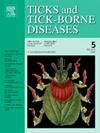Ultrastructural changes in the midgut of Ixodes ricinus nymphs across feeding and digestion stages
IF 3.4
2区 医学
Q2 INFECTIOUS DISEASES
引用次数: 0
Abstract
Ticks rely on host blood as their primary source of nutrients and energy. In hard ticks (Ixodidae), a single blood meal per life stage supports survival, metamorphosis, and, in females, egg production. The midgut, the major metabolic organ, is responsible for both digestion and nutrient storage. While previous studies have described tick midgut histology, many foundational works, often decades old, lacked modern histochemical, immunohistochemical, and high-resolution imaging techniques. Moreover, inconsistent nomenclature of midgut cells across species complicates comparative analyses. We herein chronologically examined structural changes in Ixodes ricinus nymphal midgut tissue before, during, and after feeding. Using immunofluorescence and immunoelectron microscopy, we monitored lipid droplet dynamics and the uptake of blood-derived proteins, including hemoglobin and serum albumin. To further investigate endocytic processes, we employed serial block-face scanning electron microscopy and TEM tomography, focusing on midgut samples from nymphs fed for 48 h. These approaches allowed us to visualize in 3D hemoglobin and albumin uptake from the gut lumen and their intracellular distribution within the nymphal caecum and midgut cells. Our findings enhance the understanding of tick gut cell biology, particularly nutrient processing and energy metabolism, providing a foundation for future research on tick physiology and vector competence.

摄食期和消化期蓖麻若虫中肠超微结构的变化
蜱依靠宿主的血液作为营养和能量的主要来源。在硬蜱(伊蚊科)中,每个生命阶段只吃一顿血就能维持生存、变态和雌性产卵。中肠是主要的代谢器官,负责消化和营养储存。虽然以前的研究描述了蜱虫的中肠组织学,但许多基础工作,通常是几十年前的,缺乏现代组织化学,免疫组织化学和高分辨率成像技术。此外,跨物种中肠细胞的命名不一致使比较分析复杂化。我们在此按时间顺序研究了在喂食前、喂食期间和喂食后蓖麻虫淋巴中肠组织的结构变化。利用免疫荧光和免疫电镜,我们监测了脂滴动力学和血源性蛋白的摄取,包括血红蛋白和血清白蛋白。为了进一步研究内吞过程,我们使用了连续的块面扫描电子显微镜和TEM断层扫描,聚焦于喂食48小时的稚虫的中肠样本。这些方法使我们能够在3D中可视化从肠腔摄取的血红蛋白和白蛋白,以及它们在淋巴盲肠和中肠细胞内的细胞内分布。我们的研究结果增强了对蜱肠道细胞生物学,特别是营养加工和能量代谢的认识,为蜱生理学和媒介能力的进一步研究提供了基础。
本文章由计算机程序翻译,如有差异,请以英文原文为准。
求助全文
约1分钟内获得全文
求助全文
来源期刊

Ticks and Tick-borne Diseases
INFECTIOUS DISEASES-MICROBIOLOGY
CiteScore
6.90
自引率
12.50%
发文量
185
审稿时长
6-12 weeks
期刊介绍:
Ticks and Tick-borne Diseases is an international, peer-reviewed scientific journal. It publishes original research papers, short communications, state-of-the-art mini-reviews, letters to the editor, clinical-case studies, announcements of pertinent international meetings, and editorials.
The journal covers a broad spectrum and brings together various disciplines, for example, zoology, microbiology, molecular biology, genetics, mathematical modelling, veterinary and human medicine. Multidisciplinary approaches and the use of conventional and novel methods/methodologies (in the field and in the laboratory) are crucial for deeper understanding of the natural processes and human behaviour/activities that result in human or animal diseases and in economic effects of ticks and tick-borne pathogens. Such understanding is essential for management of tick populations and tick-borne diseases in an effective and environmentally acceptable manner.
 求助内容:
求助内容: 应助结果提醒方式:
应助结果提醒方式:


